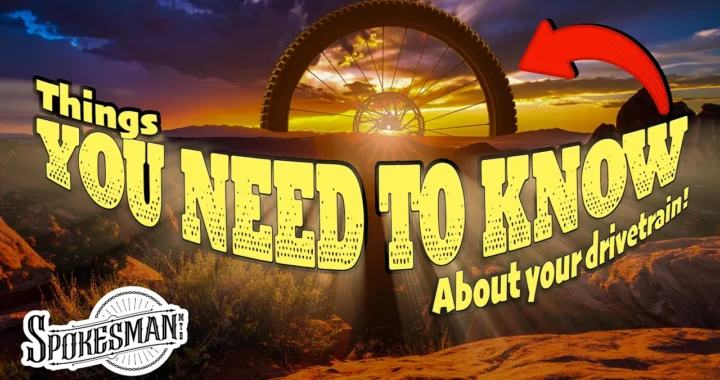Not all dogs are friendly. What can you do if you are attacked during a ride?
This video is as much about responsible pet ownership as it is about what to do if things should go wrong. I don’t want this message to come off as “anti-dog”, so I’ll say right now that, if you are a dog owner, it is your job to keep your animal under control whether there is a leash rule on the trail or not.
If you are a dog owner, it is your job to
keep your animal under control
whether there is a leash rule on the trail or not.
The responsibility for any animal attack falls upon the animal’s owner, not the person being attacked. Know your local laws and stay safe.
Leash Laws
If you ride trails, or if you ride roads, a situation that involves dealing with animals will come up eventually. It’s inevitable.
The most common places where a cyclist might have direct contact with an animal are residential yards, or on public trails.
While it is common to see dogs in front yards, and while many of them are friendly, some of them can be aggressive.
If an aggressive dog is on leash, you are generally safe. It’s a lot less likely to be able to get to you. An unleashed dog, however, can be a danger to a hiker or biker.
Violation of leash laws hurts everyone. The owner, the dog, and especially the person under attack.
When Attacks Happen
An attack is defined as any aggressive encounter with an animal when that animal is not under the explicit control of its owner. An attack does not have to involve a bite or other injury.
I have been bit in a dog attack. Trust me – this is not a memory you want to have in your life. Few things are less pleasant than being at the mercy of an uncontrolled animal.
Dogs primarily attack because they are either protecting people or property, or they are responding to their instinct to chase. During the initial moments of the attack, it can be very difficult to tell whether the dog is intent on causing harm, or just curious and loud.
Laws in most areas require unsupervised dogs to be leashed or contained. Local pet codes are available on the websites of most municipalities or counties. It’s a good idea to know the codes in the areas you plan to ride.
Park systems will generally have their pet policies listed on their websites. If they aren’t located there, they can usually also be found on the park’s signage.
Even on national forest lands, the laws can vary from place to place. The national parks that allow pets have a federal regulation that requires 6 foot maximum leashes on dogs.
In most situations, dogs are allowed on municipal and county public access trail systems. The only time I have seen trails that explicitly ban dogs is when those trails are bike-specific. It’s pretty obvious that, when a trail has been cut solely for bike use, it’s not a very safe place for dogs to roam; on or off leash.
In Durango, Colorado, a cyclist on a paved path was recently killed while legally riding their bike. An illegally unleashed dog ran in front of them and they were thrown from the bike. The rider later died from injuries sustained during that encounter.
If you are attacked, the most important thing to remember is to not overreact. Most dogs will sense when tension is high, and that may aggravate them.
Do your best to stay calm and to act slowly and rationally.
The first thing to do after the initial encounter is to contact the dog’s owner. If the person who should be controlling the animal is immediately available, call out to them and ask if their dog is dangerous.
This can often be enough to diffuse the situation. If the owner sees that their animal is causing discomfort or panic, or that their animal is being aggressive, they are likely to jump in and assert control over the dog.
I have never met a dog owner who
wants their animal to attack strangers.
If an owner cannot be located, remain calm and put as much distance as you can between the animal and you. Don’t sprint away, the dog may give chase.
Move slowly and in a controlled manner and talk to the animal. Loudly tell the dog to sit or stay, this sometimes works.
Try to be upbeat and use a happy voice. This isn’t always easy when you are facing an attack, but it may help change the mood of the animal.
I have seen people use air horns to startle aggressive dogs. This may likely cause the animal to back off, but it’s not particularly practical.
Dealing with Bites
What if the dog doesn’t back off?
If you are on a bike, place the bike between you and the dog. As long as it is safe, slowly move away from the animal, increasing the distance between you. If you get far enough away, the dog may sense that you are leaving its protected area and disengage.
This can also be a good time to pick up a rock, if you can. Be ready to throw it as a distraction or to hold onto, in case you need a defensive tool.
Throwing rocks (not at the dog) sometimes acts as a distraction. It can occupy the dog’s other instincts and cause it to pursue the object thrown.
I have had success shouting at aggressive dogs. I have a lower voice, and I can get loud when I need to. I have been known to give a round of “HEY HEY”s and it has worked.
If the dog bites you
All bets are off. Your primary job in this situation is to protect yourself and others from harm. If the dog in question is actively biting, then it is acceptable to take action to end the conflict.
Let’s be real here – I’m not advocating for harming animals. I’m saying that, if you are under attack, it is acceptable to defend yourself.
After the conflict, the first thing to do is seek medical assistance. If you can, get to a clinic or hospital. Use Google to search for the closest place. I tried testing local emergency rooms using Siri, and it was absolutely useless.
Most voice assistants will help you call 911.
You may need to call an ambulance. If your wound is severe, if you are immobilized, or if you are too remote to get yourself to immediate medical attention, then contact emergency services any way you can and make sure that an emergency room is your next stop.
After you have received medical attention, contact local authorities and make sure they have a full description of the animal, the location of the incident, the time it happened, and any other important details you think they may need. This will help them file an accurate report.
Rabies
If you are bit by an animal that cannot be tested for rabies, you will need to get treated. If you travel in areas where it is difficult or impossible to treat rabies, it is possible to receive an advance vaccination in the form of “PrEP”.
PrEP stands for “Pre-Exposure Prophylaxis”. It involves a series of vaccinations that are received prior to possible exposure to the rabies virus. Treatment still requires post-exposure boosters, but the PrEP path can save the life of a person that may not be able to receive an immediate post-bite vaccination.
If you are interested in learning more about PrEP, click this link, or ask your medical professional.
Tips
- Don’t hate the animals. Dogs can be aggressive, sometimes dangerously so. But this is the fault of the dog’s owner, not the dog. It falls upon the owner to know and follow local animal control laws and regulations.
- Dogs are only as docile as they are trained to be. I’ve seen sweet, peaceful pitbulls and dangerous, aggressive golden retrievers. The dogs just want to please their masters.
- Don’t sprint away from an aggressive dog. Running or riding fast is more likely to spur the dog into a chase, and that’s bad news.
- Remember – dogs can very successfully bite you while you are pedaling!
- Pet owners are liable for the negligent actions of their pets. Laws vary from place to place, but the responsibility of safety overwhelmingly falls upon the owner of the animal in question.
- And if you are a pet owner, know your laws. Breaking them, or putting others at risk can endanger the safety and freedom of you and your pet.
- The two most often mentioned deterrents against attacking dogs are air horns and pepper/bear spray. While the former is mostly a distraction technique, the latter can harm the animal but is far more likely to end the conflict.
- Review safety procedures for any tool or deterrent you may need to use against an animal. Also make sure that use of that solution is legal in your area.
Riding bikes can be fun and friendly, but it is important to be prepared, should the worst happen. Let’s all work together to enjoy the trails and roads, and to make sure our furry friends also have a place to enjoy the outdoors!
Rabies advance inoculation information (via the CDC website):
https://www.cdc.gov/rabies/hcp/clinical-care/pre-exposure-prophylaxis.html


